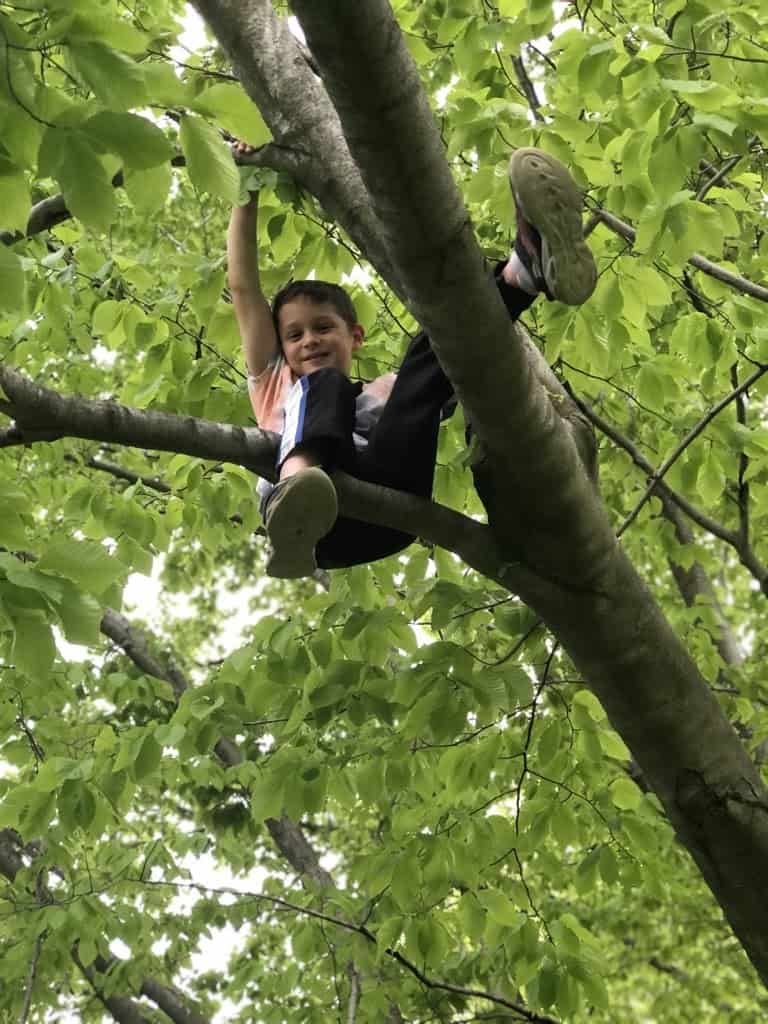I have a son that likes to climb. In fact, when he was around 4, he would climb the baseball diamond backstop. He would climb all the way up and dangle his feet off the edge. Adults would walk by and say, “Should he be doing that”? And I would say, “I don’t know, but he’s having a good time.”
He was fearless, happy and proud. I get acrophobia (fear or heights) just watching him. But I would rather look the other way than tell him to stop climbing. He wasn’t afraid, and I didn’t want to create a fear for him.
Over the years, my son has gained the ability and skill to climb. He’s confident in his body because he’s had the space to develop the skill. If I had I let my fears drive his options, I would have prevented him from developing this skill he’s very proud of. What fears might you have that you are passing on to others?

Why Should You Face Your Fears?
The experience of feeling fear is natural. It’s kept us alive for millions of years. We would see a predator and feel the fear to know to run away. However, our worries have developed over the years into other things. That fear from the beginning of time is still protecting us. We don’t want to get hurt.
And yet, we do need to take risks to grow.
For example, you know it’s time to break up with your partner. But you don’t want to get hurt, feel the pain. And it’s clear that the relationship is over. In this case, it can be helpful to put a time frame on it. If the situation hasn’t improved (with mutual effort) by X time, can you commit to moving on?
You can’t outrun the pain of a break up. You can dull it with the excitement of a new relationship, but that can keep you from thinking clearly.
I believe that as much joy and happiness as you feel in your life, you’ll feel the same amount of pain. Happiness and connection leads to feelings of sadness and pain when there is loss. They work as partners. Pain reminds you how much something has meant to you.
You want to feel your fear. You wouldn’t go bungee jumping and be not fee;l afraid. That’s not normal. It’s against our biology. But it doesn’t mean you stop when you feel the fear. Part of the rush, the thrill of the jump is feeling the fear, facing it, and doing it anyway!
How Do You Get Over Fear?
To face your fears, you don’t need to take a leap of faith (unless of course you are bungee jumping, then you are literally taking a leap of faith).
A few years ago, I was hosting a show for Yahoo called Blue Ribbon Hunter, where I traveled the country finding unusual foods. As part of one show, I was asked to eat a cicada. Oy. The thought of that made me shiver. A cicada is a giant insect, very common in my area of the Northeastern United States. They swarm, they’re massive, they’re noisy. It’s not like swallowing a small bug or a worm (which I also did). This thing would have a crunch.
If the idea of eating cicada doesn’t bring a chill down your spine, take a look at this:

My fake eyelashes don’t make it any more appealing.
So to get ready to eat the cicada, which I knew I had to do, I took a minute. I didn’t just put it in my mouth and swallow. I had to take baby steps to face my fears.
I spent the day with a chef who was preparing the cicada. I learned about them and the role they played in his culture. I learned about the nutritious value bugs can provide. I watched the chef prepare it by seeing him dehydrate it, then make a delicious marinate for it. By 1) recognizing the value of eating the bug, 2) appreciating the care he put into preparing it and 3) understanding that I was not alone in cicada consumption, eating this cicada became more compelling. I replaced my fear with curiosity, and by the time I needed to eat it, I was excited to do so.
I faced my fear. I spent the time becoming ready for the inevitable, to become curious about it and even, to look forward to it. You can do the same for your fears.
3 Step Process to Face Your Fears
Step 1: Acknowledge that you’re afraid of something that you’ve committed to do.
Step 2: Determine specifically what you’re afraid of, mitigate concerns if possible.
Step 3: Accept the fear, be curious about the opportunity, and proceed.
Following these steps allow you to move past your fear. In Feel the Fear and Do It Anyway Susan Jeffers recognizes that we can’t avoid feelings of fear. In the cicada example, I was afraid. I accepted that afraid, and proceeded, committed to the outcome. Don’t let fear stop you, welcome the fear with, “Hello. I’m listening to you, but you’re preventing my growth.”
Determine what specifically you’re afraid of. For me, the cicada was dead. I was afraid of the creepy crawly gross cicada. But this one wasn’t moving, and I could remember all the other animals that I eat that aren’t moving.
My curiosity really helped. As I learned more about eating cicadas, watched the chef prepare it and even eat a few himself, my fear just sort of dissipated. Normalizing the behavior really helps.
Start small when it comes to facing your fear. See if you can attack a few pebbles before going after the whole boulder. Give yourself a smaller challenge related to that action you’re afraid of.
Applying the Steps to the World
Many of my clients fear leaving their job. They’re afraid that they won’t find work or that an unemployed person is less attractive to hire. These are fears, they are not reality.
Your current job may be depleting you, it may be mentally exhausting. Some of my clients work 60-80 hour work weeks. They don’t have the mental space to look at other jobs or the time to interview.. They may need to quit to have the time to find a job.
Before we do something as bold as quitting without a job, we mitigate the risk, look at their money, and determine if they can fund their job search.
If working long hours doesn’t allow you to think of other ideas. It may be time to quit.
I have a friend who was working 50-60 hours every week. It was a labor-intensive job and he hated it. He was miserable. And he had a dream.. He wanted to become a personal trainer, but working long hours never gave him the option to pursue his certification. He was stuck. My friend had two choices. Continue working these long hours, continuing to feel stuck and miserable or quit.
Choosing to quit was his best decision. He invested in himself and his passion. He purchased the certification course, committed to it, got certified within two weeks and found a job as a personal trainer the week after that.
Quitting isn’t always the answer. And not having the mental energy to pursue better options can lead to significant stuckness. Sometimes you need to quit to have space like my friend; quitting allowed him to have the energy. Facing your fears will be scary, and ultimately it will free you to do something you want to do.
Fear is the negative belief that something might occur. You can choose to build it up in your head or face your fears it as a possibility and move forward. As a life coach, I will help you feel the fear, mitigate it, find your curiosity, and do it anyway.
When you move forward, fears and all, you’re growing. If you want to take the next step, reach out and schedule an introductory session. I’m here to support you.



